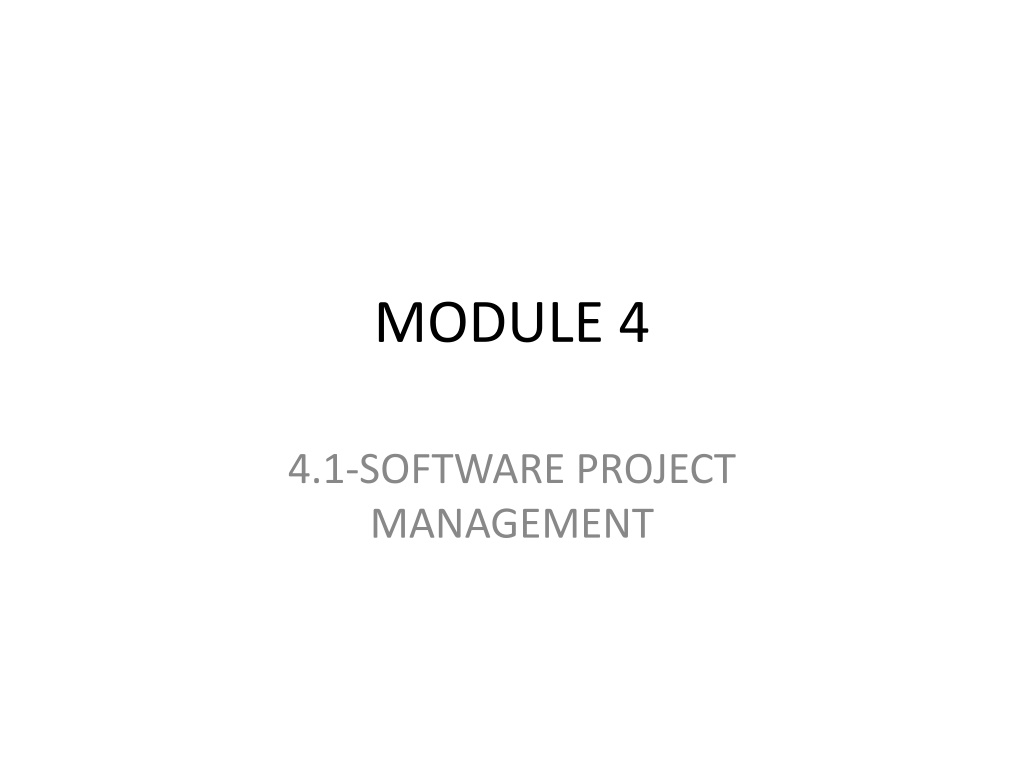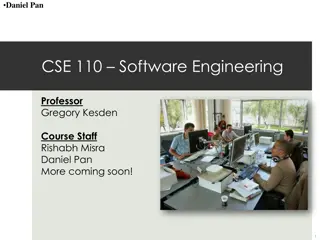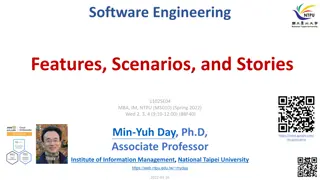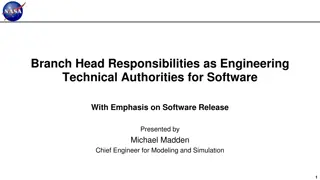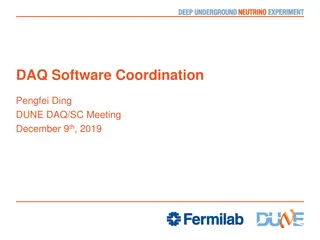Essential Aspects of Software Project Management
Software project management plays a crucial role in ensuring project success by meeting budget and schedule constraints while delivering high-quality software. Key activities like project planning, risk management, people management, reporting, and proposal writing are essential for effective project management in software engineering.
Download Presentation

Please find below an Image/Link to download the presentation.
The content on the website is provided AS IS for your information and personal use only. It may not be sold, licensed, or shared on other websites without obtaining consent from the author. Download presentation by click this link. If you encounter any issues during the download, it is possible that the publisher has removed the file from their server.
E N D
Presentation Transcript
MODULE 4 4.1-SOFTWARE PROJECT MANAGEMENT
PROJECT MANAGEMENT Software project management is an essential part of software engineering. Projects need to be managed because professional software engineering is always subject to organizational budget and schedule constraints. The project manager's job is to ensure that the software project meets and overcomes these constraints as well as delivering high-quality software. Good management cannot guarantee project success. However, bad management usually results in project failure: The software may be delivered late, cost more than originally estimated, or fail to meet the expectations of customers. The success criteria for project management obviously vary from project to pro ject, but, for most projects, important goals are: to deliver the software to the customer at the agreed time: to keep overall costs within budget; to deliver software that meets the customer's expectations; to maintain a coherent and well-functioning development team.
However, a number of fundamental project management activities are common to all organizations: 1. Project planning Project managers are responsible for planning, estimating, and scheduling project development and assigning people to tasks. They supervise the work to ensure that it is carried out to the required standards, and they monitor progress to check that the development is on time and within budget. 2. Risk management Project managers have to assess the risks that may affect a project, monitor these risks, and take action when problems arise. 3. People management Project managers are responsible for managing a team of people. They have to choose people for their team and establish ways of work ing that lead to effective team performance. 4. Reporting Project managers are usually responsible for reporting on the progress of a project to customers and to the managers of the company developing the software. They have to be able to communicate at a range of levels, from detailed technical information to management summaries. They have to write concise, coherent documents that abstract critical information from detailed project" reports. They must be able to present this information during progress reviews. 5. Proposal writing The first stage in a software project may involve writing a proposal to win a contract to carry out an item of work. The proposal describes the objectives of the project and how it will be carried out. It usually includes cost and schedule estimates and justifies why the project contract should be awarded to a particular organization or team. Proposal writing is a critical task as the survival of many software companies depends on having enough proposals accepted and contracts awarded.
1 Risk management Risk management one of the most important jobs a project manager. a risk as something that you'd prefer to have happen. Risks may the project, the is software that is being developed, or the organization. A complementary classification is to classify risks according to what these risks affect. 1. Project risks affect the project schedule or resources. An example of a project risk is the loss of an experienced system architect. Finding a replacement archi tect with appropriate skills and experience may take a long time; consequently, it will take longer to develop the software design than originally planned. 2. Product risks affect the quality or performance of the software being developed. An example of a product risk is the failure of a purchased component to perform
as expected. This may affect the overall performance of the system so that it is slower than expected. 3. Business risks affect the organization developing or procuring the software. For example, a competitor introducing a new product is a business risk. The introduction of a competitive product may mean that the assumptions made about sales of existing software products may be unduly optimistic
The specific risks that may affect a project depend on the project and the organizational environment in which the software is being developed. However, there are also common risks that are independent of the type of software being developed. These can occur in any software development project. Some examples of these common risks are shown in Figure 22.1.Software risk management is important
An outline of the process of risk management is presented in Figure 22.2. It involves several stages: 1. Risk identification You should identify possible project, product, and business risks. 2. Risk analysis You should assess the likelihood and consequences of these risks. 3. Risk planning You should make plans to address the risk, either by avoiding it or by minimizing its effects on the project. 4. Risk monitoring You should regularly assess the risk and your plans for risk mitigation and revise these plans when you learn more about the risk.
1.1 Risk identification Risk identification is the first stage of the risk management process. It is concerned with identifying the risks that could pose a major threat to the software engineering process, the software being organization. Risk identification may be a team process in which a team gets together to brainstorm possible risks. Alternatively, project managers may identify risks based on their experience of what went wrong on previous projects. As a starting point for risk identification, a checklist of different types of risk may be used. Six types of risk may be included in a risk checklist: 1. Estimation risks arise from the management estimates of the resources required to build the system. 2. Organizational risks arise from the organizational environment where the software is being developed. 3. People risks are associated with the people in the development team. 4. Requirements risks come from changes to the customer requirements and the process of managing the requirements change. 5. Technology risks come from the software or hardware technologies that are used to develop the system. 6. Tools risks come from the software tools and other support software used to develop the system. developed, or the development
1.2 Risk analysis During the risk analysis process, you have to consider each identified risk and make a judgment about the probability and seriousness of that risk. There is no easy way to do so. You have to rely on your judgment and experience of previous projects and the problems that arose in them. It is not possible to make precise, numeric assessment of the probability and seriousness of each risk. Rather, you should assign the risk to one of a number of bands: 1. The probability of the risk might be assessed as insignificant, low, moderate, high, or very high. 2. The effects of the risk might be assessed as catastrophic (threaten the survival of the project), serious (would cause major delays), tolerable (delays are within allowed contingency), or insignificant.
1.3 Risk planning The risk planning process develops strategies to manage the key risks that threaten the project. For each risk, you have to think of actions that you might take to minimize the disruption to the project if the problem identified in the risk occurs. You should also think about the information that you need to collect while monitoring the project so that emerging problems can be detected before they become serious. In risk planning, you have to ask what-if questions that consider both individual risks, combinations of risks, and external factors that affect these risks. For example,questions that you might ask are: 1. What if several engineers are ill at the same time? 2. What if an economic downturn leads to budget cuts of 20% for the project? 3. What if the performance of open-source software is inadequate and the only expert on that open-source software leaves? 4. What if the company that supplies and maintains software components goes out of business? 5. What if the customer fails to deliver the revised requirements as predicted?
Based on the answers to these what-if questions, you may devise strategies for managing the risks. Figure 22.5 shows possible risk management strategies that have been identified for the key risks (i.e., those that are serious or intolerable) shown in Figure 22.4. These strategies fall into three categories: 1. Avoidance strategies Following these strategies means that the probability that the risk will arise is reduced.An example of a risk avoidance strategy is the strategy for dealing with defective components shown in Figure 22.5. 2. Minimization strategies Following these strategies means that the impact of the risk is reduced.An example of a risk minimization strategy is the strategy for staff illness shown in Figure 22.5. 3. Contingency plans Following these strategies means that you are prepared for the worst and have a strategy in place to deal with it.An example of a contingency strategy is the strategy for organizational financial problems that I have shown in Figure 22.5.
1.4 Risk monitoring Risk monitoring is the process of checking that your assumptions about the product, process, and business risks have not changed. You should regularly assess each of the identified risks to decide whether or not that risk is becoming more or less probable. Figure 22.6 gives some examples of factors that may be helpful in assessing these risk types. You should monitor risks regularly at all stages in a project.At every management review, you should consider and discuss each of the key risks separately.You should decide if the risk is more or less likely to arise and if the seriousness and consequences of the risk have changed.
2 Managing people The people working in a software organization are its greatest assets. It is expensive to recruit and retain good people, and it is up to software managers to ensure that the engineers working on a project are as productive as possible. In successful companies and economies, this productivity is achieved when people are respected by the organization and are assigned responsibilities that reflect their skills and experience. It is important that software project managers understand the technical issues that influence the work of software development. Unfortunately, however, good software engineers are not always good people managers. Software engineers often have strong technical skills but may lack the softer skills that enable them to motivate and lead a project development team. As a project manager, you should be aware of the potential problems of people management and should try to develop people management skills.
There are four critical factors that influence the relationship between a manager and the people that he or she manages: 1. Consistency All the people in a project team should be treated in a comparable way. No one expects all rewards to be identical, but people should not feel that their contribution to the organization is undervalued. 2. Respect Different people have different skills, and managers should respect these differences. All members of the team should be given an opportunity to make a contribution. In some cases, of course, you will find that people simply don t fit into a team and they cannot continue, but it is important not to jump to conclusions about them at an early stage. 3. Inclusion People contribute effectively when they feel that others listen to them and take account of their proposals. It is important to develop a working environment where all views, even those of the least experienced staff, are considered. 4. Honesty As a manager, you should always be honest about what is going well and what is going badly in the team. You should also be honest about your level of technical knowledge and be willing to defer to staff with more knowledge when necessary. If you try to cover up ignorance or problems, you will eventually be found out and will lose the respect of the group.
2.1 Motivating people In practice, motivation means organizing work and its environment to encourage people to work as effectively as possible. If people are not motivated, they will be less interested in the work they are doing. They will work slowly, be more likely to make mistakes, and will not contribute to the broader goals of the team or the organization. These needs are arranged in a series of levels, as shown in Figure 22.7. The lower levels of this hierarchy represent fundamental needs for food, sleep, and so on, and the need to feel secure in an environment. Social need is concerned with the need to feel part of a social grouping. Esteem need represents the need to feel respected by others, and self-realization need is concerned with personal development. People need to satisfy lower-level needs such as hunger before the more abstract, higher-level needs.
Making sure that peoples social, esteem, and self-realization needs are satisfied is most important from a management point of view. 1. To satisfy social needs, you need to give people time to meet their co-workers and provide places for them to meet. Software companies such as Google provide social space in their offices for people to get together. This is relatively easy when all of the members of a development team work in the same place, but, increasingly, team members are not located in the same building Social networking systems and teleconferencing can be used for remote communications, but my experience with these systems is that they are most effective when people already know each other. 2. To satisfy esteem needs, you need to show people that they are valued by the organization. Public recognition of achievements is a simple and effective way of doing this. Obviously, people must also feel that they are paid at a level that reflects their skills and experience. 3. Finally, to satisfy self-realization needs, you need to give people responsibility for their work, assign them demanding (but not impossible) tasks, and provide opportunities for training and development where people can enhance their skills. Training is an important motivating influence as people like to gain new knowledge and learn new skills.
In Figure 22.8, Illustrate a problem of motivation that managers often have to face. In this example, a competent group member loses interest in the work and in the group as a whole. The quality of her work falls and becomes unacceptable. This situation has to be dealt with quickly. If you don t sort out the problem, the other group members will become dissatisfied and feel that they are doing an unfair share of the work. Personal difficulties commonly affect motivation because people cannot therefore concentrate on their work. You may have to give them time and support to resolve these issues, although you also have to make it clear that they still have a responsibility to their employer. Dorothy s motivation problem is one
Personal difficulties commonly affect motivation because people cannot therefore concentrate on their work. You may have to give them time and support to resolve these issues, although you also have to make it clear that they still have a responsibility to their employer. Psychological personality type also influences motivation. Bass and Dunteman (Bass and Dunteman 1963) identified three classifications for professional workers: 1. Task-oriented people, who are motivated by the work they do. In software engineering, these are people who are motivated by the intellectual challenge of software development. 2. Self-oriented people, who are principally motivated by personal success and recognition. They are interested in software development as a means of achieving their own goals. They often have longer-term goals, such as career progression, that motivate them, and they wish to be successful in their work to help realize these goals. 3. Interaction-oriented people, who are motivated by the presence and actions of co-workers. As more and more attention is paid to user interface design, interaction- oriented individuals are becoming more involved in software engineering.
2.3 Teamwork It is impossible for everyone in a large group to work together on a single problem, Large teams are usually split into a number of smaller groups. Each group is responsible for developing part of the overall system. The best size for a software engineering group is 4 to 6 members, and they should never have more than 12 members. When groups are small, communication problems are reduced. Everyone knows everyone else, and the whole group can get around a table for a meeting to discuss the project and the software that they are developing.
Putting together a group that has the right balance of technical skills, experience, and personalities is a critical management task. Agood group is cohesive and thinks of itself as a strong, single unit. The people involved are motivated by the success of the group as well as by their own personal goals. In a cohesive group, members think of the group as more important than the individuals who are group members. Members of a well-led, cohesive group are loyal to the group. They identify with group goals and other group members. They attempt to protect the group, as an entity, from outside interference. This makes the group robust and able to cope with problems and unexpected situations.
The benefits of creating a cohesive group are: 1. The group can establish its own quality standards Because these standards are established by consensus, they are more likely to be observed than external standards imposed on the group. 2. Individuals learn from and support each other Group members learn by working together. Inhibitions caused by ignorance are minimized as mutual learning is encouraged. 3. Knowledge is shared Continuity can be maintained if a group member leaves. others in the group can take over critical tasks and ensure that the project is not unduly disrupted. 4. Refactoring and continual improvement is encouraged Group members work collectively to deliver high-quality results and fix problems, irrespective of the individuals who originally created the design or program.
Good project managers should always try to encourage group cohesiveness. They may try to establish a sense of group identity by naming the group and establishing a group identity and territory. Some managers like explicit group-building activities such as sports and games, although these are not always popular with group members. Social events for group members and their families are a good way to bring people together. One of the most effective ways of promoting cohesion is to be inclusive. That is, you should treat group members as responsible and trustworthy, and make information freely available. Sometimes managers feel that they cannot reveal certain information to everyone in the group. This invariably creates a climate of mistrust. An effective way of making people feel valued and part of a group is to make sure that they know what is going on.
Given a stable organizational and project environment, the three factors that have the biggest effect on team working are: 1. The people in the group You need a mix of people in a project group as software development involves diverse activities programming,testing, and documentation. 2. The way the group is organized Agroup should be organized so that individuals can contribute to the best of their abilities and tasks can be completed as expected. 3. Technical and managerial communications Good communication between group members, and between the software engineering team and other project stakeholders, is essential. such as negotiating with clients,
3.1 Selecting group members A manager or team leader s job is to create a cohesive group and organize that group so that they work together effectively. This task involves selecting a group with the right balance of technical skills and personalities. Sometimes people are hired from outside the organization; more often, software engineering groups are put together from current employees who have experience on other projects. Technical knowledge and ability should not be the only factor used to select group members . People who are motivated by the work are likely to be the strongest technically. People who are self-oriented will probably be best at pushing the work forward to finish the job. People who are interaction-oriented help facilitate communications within the group.
2.3 Group organization The way a group is organized affects the group s decisions, the ways information is exchanged, and the interactions between the development group and external project stakeholders. Important organizational questions for project managers include the following: 1. Should the project manager be the technical leader of the group? The technical leader or system architect is responsible for the critical technical decisions made during software development. 2. Who will be involved in making critical technical decisions, and how will these decisions be made? Will decisions be made by the system architect or the project manager or by reaching consensus among a wider range of team members? 3. How will interactions with external stakeholders and senior company management be handled? In many cases, the project manager will be responsible for these interactions, assisted by the system architect if there is one..
4. How can groups integrate people who are not co-located? It is now common for groups to include members from different organizations and for people to work from home as well as in a shared office. This change has to be considered in group decision-making processes. 5. How can knowledge be shared across the group? Group organization affects information sharing as certain methods of organization are better for sharing than others. However, you should avoid too much information sharing as people become overloaded and excessive information distracts them from their work.
Small programming groups are usually organized in an informal way. The group leader gets involved in the software development with the other group members. In an informal group, the group as a whole discusses the work to be carried out, and tasks are allocated according to ability and experience. More senior group members may be responsible for the architectural design. Agile development teams are always informal groups. Agile enthusiasts claim that formal structure inhibits information exchange Informal groups can be very successful, particularly when most group members are experienced and competent. Such a group makes decisions by consensus, which improves cohesiveness and performance. If a group is composed mostly of inexperienced or incompetent members, informality can be a hindrance. With no experienced engineers to direct the work, .
In hierarchical groups the group leader is at the top of the hierarchy. He or she has more formal authority than the group members and so can direct their work. There is a clear organizational structure, and decisions are made toward the top of the hierarchy and implemented by people lower down. Hierarchical groups can work well when a well-understood problem can be easily broken down into software components that can be developed in different parts of the hierarchy. This grouping allows for rapid decision making, which is why military organizations follow this model. However, it rarely works well for complex software engineering.
In software development, effective team communications at all levels is essential: 1. Changes to the software often require changes to several parts of the system, and this requires discussion and negotiation at all levels in the hierarchy. 2. Software technologies change so fast that more junior staff may know more about new technologies than experienced staff. Top-down communications may mean that the project manager does not find out about the opportunities of using these new technologies. More junior staff may become frustrated because of what they see as old-fashioned technologies being used for development.
3.3 Group communications The effectiveness and efficiency of communications are influenced by: 1. Group size As a group gets bigger, it gets harder for members to communicate effectively. The number of one-way communication links is n * (n 1), where n is the group size, so, with a group of eight members, there are 56 possible communication pathways. This means that it is quite possible that some people will rarely communicate with each other. Status differences between group members mean that communications are often one-way. Managers and experienced engineers tend to dominate communications with less experienced staff, who may be reluctant to start a conversation or make critical remarks 2. Group structure People in informally structured groups communicate more effectively than people in groups with a formal, hierarchical structure. In hierarchical groups, communications tend to flow up and down the hierarchy. People at the same level may not talk to each other. This is a particular problem in a large project with several development groups. If people working on different subsystems only communicate through their managers, then there are more likely to be delays and misunderstandings. 3. Group composition People with the same personality types (discussed in Section 22.2) may clash, and, as a result, communications can be inhibited.
MODULE 4.2 PROJECT PLANNING
1 Project planning Project planning is one of the most important jobs of a software project manager. As a manager, you have to break down the work into parts and assign them to project team members, anticipate problems that might arise, and prepare tentative solutions to those problems. The project plan, which is created at the start of a project and updated as the project progresses, is used to show how the work will be done and to assess progress on the project.
Project planning takes place at three stages in a project life cycle: 1. At the proposal stage, when you are bidding for a contract to develop or provide a software system. You need a plan at this stage to help you decide if you have the resources to complete the work and to work out the price that you should quote to a customer. 2. During the project startup phase, when you have to plan who will work on the project, how the project will be broken down into increments, how resources will be allocated across your company, and so on. 3. Periodically throughout the project, when you update your plan to reflect new information about the software and its development. You learn more about the system being implemented and the capabilities of your development team. As software requirements change, the work breakdown has to be altered and the schedule extended. This information allows you to make more accurate estimates of how long the work will take.
The project plan always evolves during the development process because of requirements changes, technology issues, and development problems. Development planning is intended to ensure that the project plan remains a useful document for staff to understand what is to be achieved and when it is to be delivered. Therefore, the schedule, cost estimate, and risks all have to be revised as the software is developed. If an agile method is used, there is still a need for a project startup plan because regardless of the approach used, the company still needs to plan how resources will be allocated to a project. However, this is not a detailed plan, and you only need to include essential information about the work breakdown and project schedule.
1.1 Software Pricing In principle, the price of a software system developed for a customer is simply the cost of development plus profit for the developer. In practice, however, the relationship between the project cost and the price quoted to the customer is not usually so simple. When calculating a price, you take broader organizational, economic, political, and business considerations into account (Figure 23.1)
A small software company, PharmaSoft, employs 10 software engineers. It has just finished a large project but only has contracts in place that require five development staff. However, it is bidding for a very large contract with a major pharmaceutical company that requires 30 person-years of effort over two years. The project will not start for at least 12 months but, if granted, it will transform the finances of the company. PharmaSoft gets an opportunity to bid on a project that requires six people and has to be completed in 10 months. The costs (including overheads of this project) are estimated at $1.2 million. However, to improve its competitive position, PharmaSoft decides to bid a price to the customer of $0.8 million. This means that, although it loses money on this contract, it can retain specialist staff for the more profitable future projects that are likely to come on stream in a year s time.
This is an example of an approach to software pricing called pricing to win.Pricing to win means that a company has some idea of the price that the customer expects to pay and makes a bid for the contract based on the customer s expected price. This may seem unethical and unbusinesslike, but it does have advantages for both the customer and the system provider. A project cost is agreed on the basis of an outline proposal. Negotiations then take place between client and customer to establish the detailed project specification. This specification is constrained by the agreed cost. The buyer and seller must agree on what is acceptable system functionality. The fixed factor in many projects is not the project requirements but the cost. The requirements may be changed so that the project costs remain within budget.
For example, say a company (OilSoft) is bidding for a contract to develop a fuel delivery system for an oil company that schedules deliveries of fuel to its service stations. There is no detailed requirements document for this system, so OilSoft estimates that a price of $900,000 is likely to be competitive and within the oil company s budget. After being granted the contract, OilSoft then negotiates the detailed requirements of the system so that basic functionality is delivered. It then estimates the additional costs for other requirements. This approach has advantages for both the software developer and the customer. The requirements are negotiated to avoid requirements that are difficult to implement and potentially very expensive. Flexible requirements make it easier to reuse software. The oil company has awarded the contract to a known company that it can trust. Furthermore, it may be possible to spread the cost of
1.2 Plan-driven development Plan-driven or plan-based development is an approach to software engineering where the development process is planned in detail A project plan is created that records the work to be done, who will do it, the development schedule, and the work products. Managers use the plan to support project decision making and as a way of measuring progress. Plan-driven development is based on engineering project management techniques and can be thought of as the traditional way of managing large software development projects. Agile development involves a different planning process, where decisions are delayed. The problem with plan-driven development is that early decisions have to be revised because of changes to the environments in which the software is developed and used. Delaying planning decisions avoids unnecessary rework. However, the arguments in favor of a plan-driven approach are that early planning allows organizational issues (availability of staff, other projects, etc.) to be taken into account. Potential problems and dependencies are discovered before the project starts, rather than once the project is underway. In my view, the best approach to project planning involves a sensible mixture
The best approach to project planning involves a sensible mixture of plan-based and agile development. The balance depends on the type of project and skills of the people who are available. At one extreme, large security and safetycritical systems require extensive up- front analysis and may have to be certified before they are put into use. These systems should be mostly plan-driven. At the other extreme, small to medium-size information systems, to be used in a rapidly changing competitive environment, should be mostly agile. Where several companies are involved in a development project, a plan-driven approach is normally used to coordinate the work across each development site.
2.1 Project plans In a plan-driven development project, a project plan sets out the resources available to the project, the work breakdown, and a schedule for carrying out the work. The plan should identify the approach that is taken to risk management as well as risks to the project and the software under development. The details of project plans vary depending on the type of project and organization but plans normally include the following sections: 1. Introduction Briefly describes the objectives of the project and sets out the constraints (e.g., budget, time) that affect the management of the project. 2. Project organization Describes the way in which the development team is organized, the people involved, and their roles in the team.
3. Risk analysis Describes possible project risks, the likelihood of these risks arising, and the risk reduction strategies (discussed in Chapter 22) that are proposed. 4. Hardware and software resource requirementsSpecifies the hardware and support software required to carry out the development. If hardware has to be purchased, estimates of the prices and the delivery schedule may be included. 5. Work breakdownSets out the breakdown of the project into activities and identifies the inputs to and the outputs from each project activity. 6. Project schedule Shows the dependencies between activities, the estimated time required to reach each milestone, and the allocation of people to activities. The ways in which the schedule may be presented are discussed in the next section of the chapter. 7. Monitoring and reporting mechanisms Defines the management reports that should be produced, when these should be produced, and the project monitoring mechanisms to be used.
The main project plan should always include a project risk assessment and a schedule for the project. In addition, you may develop a number of supplementary plans for activities such as testing and configuration management. Figure 23.2 shows some supplementary plans that may be developed.
2.2 The planning process Project planning is an iterative process that starts when you create an initial project plan during the project startup phase. Figure 23.3 is a UML activity diagram that shows a typical workflow for a project planning process.
At the beginning of a planning process, you should assess the constraints affecting the project. These constraints are the required delivery date, staff available, overall budget, available tools, and so on. In conjunction with this assessment, you should also identify the project milestones and deliverables. Milestones are points in the schedule against which you can assess progress, for example, the handover of the system for testing. Deliverables are work products that are delivered to the customer, for example, a requirements document for the system.
